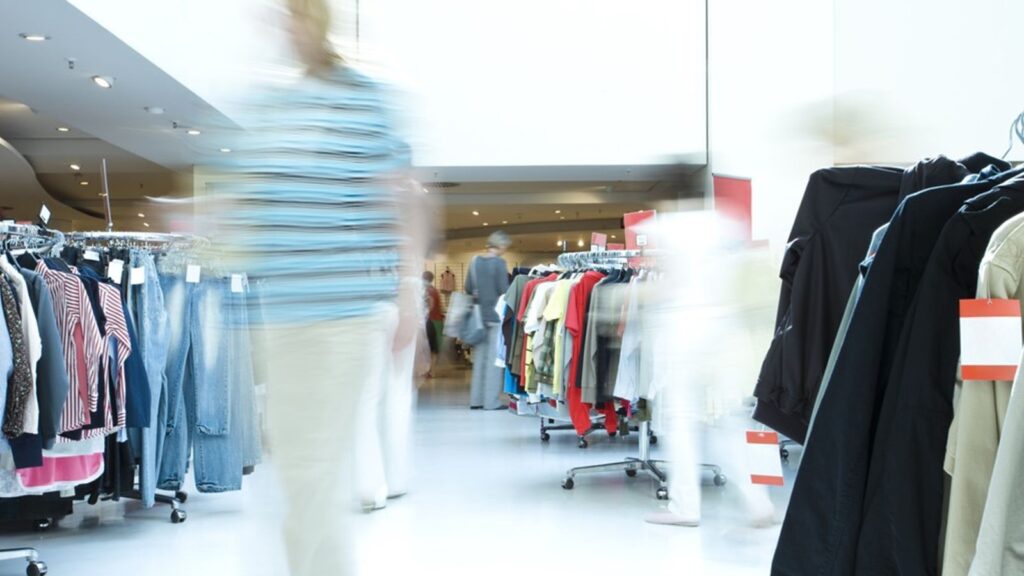We’ve all been there. You’re having a bad day and need a little advice – so head straight to your favorite website to buy something new.
That dopamine hit you get when you buy something is what many businesses rely on – and no one seems to understand it better than fast fashion brands.
But not only is this hurting our wallets, it’s also hurting the planet.
In the latest installment of our shopping psychology series from the Money blog team, we spoke to honest fashion activist Venetia La Manna (@venetialamanna) – who advocates for a more sustainable approach to clothing – about the little tricks that use fast fashion companies to get people to spend, spend, spend…
Always in a hurry – and slippery floors
Many of the techniques used by fashion companies involve making people feel rushed to make purchasing decisions.
Ms La Manna says websites and social media sites are designed to make them seem “very immediate”, so we “always feel like we have to buy something before it’s gone” – meaning that you are unable to sit down with a purchase and think about whether you need it.
Fast fashion companies also observe trends and push products as quickly as possible to ensure that people are “buying very, very quickly without necessarily thinking too much.”
And the sense of urgency is not limited to online stores.
Ms La Manna says physical clothing stores will make sure their floors are slippery “so you can move around more easily”.
Often they will even have loud music to encourage “frenzy shopping”.
They know what you want
Fashion sites use “very advanced” search engine optimization to find out what kind of products their customers are looking for and push those items to them, Ms La Manna says.
They also work with popular online influencers and get them to post affiliate links – meaning if you want to look like your favorite influencer or celebrity, you can shop what they’re wearing “with just a few clicks” .
Read more:
UK shop inflation now back to ‘normal levels’
Dr Martens profits fall 43%
Fashion giant Shein eyes London Stock Exchange
After all, they’re making things “very easy to shop for” and often have stores on popular social media sites like Instagram and TikTok.
Plus, there’s the issue of affordability.
Many are dropping their prices so low that “it makes you feel like ‘hey, why not’ when it’s cheaper than a sandwich or a coffee,” Ms La Manna says.
Inlet heater
Physical stores use other techniques to entice customers to buy.
For example, Ms. La Manna says the heat changes when you enter the store, so you’re “invited into a warmer environment.”
The stores are also laid out in a specific way, often placing cheaper items near the checkouts and simple clothing formulas next to each other.
Dopamine hit
With so much going on in the world, we may be more prone to falling into the spending trap than ever.
“The world is really tough and people are struggling. Buying fast fashion or buying things gives us a temporary dopamine hit, and of course we need that – when we’re hurting, when we’re feeling low, [shopping] it’s easy to reach,” says Ms. La Manna.
Despite having practiced “slow fashion” – trying to buy more and more consciously – for years, Ms La Manna says she still has moments when she thinks buying something would make her feel better. .
But she says it’s possible to get your much-needed dopamine kicks elsewhere — including being active in your community, or taking your time to find something you really want (ideally second-hand! ).
Why does it matter?
As well as being bad for your wallet, Ms La Manna says overconsumption is also bad for the planet and the garment workers who make your clothes.
She says many big fashion companies don’t pay their garment workers a living wage – with many unable to provide for their families, living in poverty and without rest.
The overproduction of clothing is also hurting communities in the global south, which are left to deal with huge piles of unwanted items, she says.
Most of the clothes sent to charity shops or recycling bins don’t end up being resold – instead they are mostly sent to countries in the global south, where communities are “left to deal with a problem that isn’t theirs”.
For more information on slow fashion, Ms. La Manna suggests checking out The Or Foundation, Remake, and the Clean Clothes Campaign.




